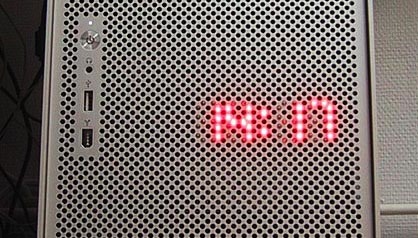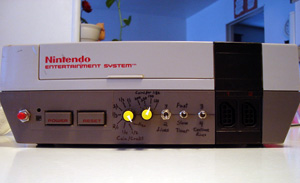Archive for the ‘Geekery’ Category
Posted by //
Sean
Date //
Jan 27, 08 - 10:27 pm
Categories //
Geekery
Google
Toys & Gadgets
Comments Off on 50th Anniversary Of The Lego Brick
Check out the Google tribute logo to the one of my favorite childhood toys, Lego bricks which is celebrating its 50th Birthday!
Taken from the official Lego website:
The 50th birthday of the LEGO brick is in January 2008 and there is plenty to celebrate. Children all over the world have played with LEGO bricks for the past 50 years, and LEGO is still right at the top of many wish lists, just as it always has been.
Industry and trade associations also recognize the LEGO success. Just before the turn of the millennium the LEGO brick was voted “Toy of the Century”, one of the highest awards in the toy industry, by both Fortune Magazine in the US and the British Association of Toy Retailers.
Legos are awesome! For those of you who missed it, check out my post about Monty Python and the Holy Grail in Lego.
Man, I could spend hours upon hours playing, building and just geeking out with my giant box-o-legos. I was fond of the little Lego people too.
My box of Lego bricks are long gone… first handed down to my younger brother, then later sold at various garage sales.
I think sometime this coming week I need to hit a local toy store and see about getting some Lego bricks for old time sake… maybe build myself a Lego laptop or robot?
Posted by //
Sean
Date //
Jan 4, 08 - 5:09 am
Categories //
Apple
Geekery
Technology
Comments Off on LED Alarm Clock Hack In Apple G5 Tower
The cheese-grater Power Mac tower is just perfect for holding a dot matrix display, and it looks like Anders Lundberg thought the same thing:

In proper hacker style, Anders took an old alarm clock, threw away the extra parts and from there, designed a circuit board.
The clock needs an external AC power supply, but what’s one more trip to Walmart?
Best of all, he’s selling kits, starting at $70 for a self assembly red LED set and $85 for the ready made.
Source: MAKE
For approximately 4 minutes you get to watch and listen to a Canadian (Steve Smith a.k.a. Red Green) take you through a tour of the 3M plant and learn the magic behind duct tape.
Be sure to pay close attention to the things the guy says while giving the tour. There are some great nuggets to be heard for sure:
After watching the video, I truly believe this guy is “in love” with duct tape.
Did you catch how he touches and caresses all the elements that go into making duct tape? Creepy for sure.
Posted by //
Sean
Date //
Nov 13, 07 - 5:43 am
Categories //
Geekery
Technology
Trivia
Comments Off on Old-School Hacker Timeline
Before the word “hacker” was wrongly associated with vandalistic script kiddies and mischievous virus writers, it was used to describe an underground culture.
This underground culture was made up of professional engineers and basement tinkerers obsessed with improving computer technology through unconventional, simple, yet brilliant tricks.
Out of this early 1960s hacker culture grew an offshoot of technological anarchists, otherwise ordinary nerds with an irrepressible desire to provoke and prod the establishment. Their exploits made them hacker gods and in some cases unexpected inmates.
1878: Young male switchboard operators at Bell telephone purposefully misdirect phone calls and listen in on the hilarious results. Bell only hires female operators from henceforth.
1961: MIT’s Tech Model Railroad Club receives its first PDP-1 computer, which it adopts as its toy of choice. The early members of the TMRC evolve a culture and slang all their own.
It’s at MIT that the term “hacker” is believed to have been born. TMRC understood hacking as inventing a quick, elegant fix for a complex problem without damaging or affecting the greater system.
1969: Dennis Ritchie and Ken Thompson at Bell Labs create the crowning achievement of ’60s-style positive hacking: Unix.
The new operating system allows many different programmers to access a computer’s resources at the same time. Unix also works on different, competing computer platforms, which are plentiful in 1969.
The US Department of Defense develops ARPANET (now the Defense Advance Research Projects Agency), the first high-speed computer network connecting universities, research laboratories, and defense contractors.
For the first time, disparate hacker groups from MIT, Stanford, Carnegie Mellon, and elsewhere can mingle and collaborate over a transcontinental network. The result is a deepening of hacker culture, lingo, and lifestyle.
- Read the Jargon File, the definitive hacker document from the ARPANET days.
 1971: John Draper, aka Cap’n Crunch, discovers that the free whistle given away in Cap’n Crunch cereal boxes can be used to gain free access to phone networks.
1971: John Draper, aka Cap’n Crunch, discovers that the free whistle given away in Cap’n Crunch cereal boxes can be used to gain free access to phone networks.
The whistle produces a perfect 2,600-MHz tone, the exact audio wavelength needed to fool the phone company’s multifrequency system into giving him a free dial tone. The practice becomes known as “phone phreaking” or just “phreaking.”
- Read the original article on phreaking from Esquire Magazine, October 1971.
- Read Cap’n Crunch’s reaction to the article.
 1971-1972: Berkeley engineering students Steve Wozniak, Steve Jobs, and Bill Klaxton contact Draper and ask to learn the ways of the blue box, the small, electronic tone device Draper invented to phreak phone networks.
1971-1972: Berkeley engineering students Steve Wozniak, Steve Jobs, and Bill Klaxton contact Draper and ask to learn the ways of the blue box, the small, electronic tone device Draper invented to phreak phone networks.
Always the prankster, Wozniak’s first phreaked call is to the pope. Against Draper’s advice, Wozniak builds some blue boxes of his own and sells them for $150 a pop.
Some of the money earned from this illegal scheme is used to fund one of Wozniak’s side projects with Jobs, a personal computing venture that would become Apple Computer.
- Read Draper’s account of his first meeting with Woz.
May 1972: Draper is arrested for phone phreaking and sentenced to four months in California’s Lompoc prison, where he teaches fellow inmates the ins and outs of hacking Ma Bell.
- Read Draper’s account of his Lompoc hacking classes.
1980: Usenet is born, networking Unix machines over slow phone lines. Usenet eventually overruns ARPANET as the virtual bulletin board of choice for the emerging hacker nation.
1982: As hacker culture begins to erode, losing some of its brightest minds to commercial PC and software start-ups, Richard Stallman starts to develop a free clone of Unix, written in C, that he calls GNU (for “Gnu’s Not Unix”).
The purest strains of old-school hackerdom are believed to survive in Stallman’s free software movement.
- Author Steven Levy chronicles the evolution of “the hacker ethic” in his groundbreaking book, Hackers: Heroes of the Computer Revolution.
1983: The movie WarGames launches a popular — if misconstrued — image of hackers headfirst into the mainstream media. Amateur interest in hacking explodes.
It’s around this same time that the term “hacking” begins to be widely applied to criminal computer behavior, confusing the original meaning of hacking forever.
Posted by //
Sean
Date //
Oct 19, 07 - 11:45 am
Categories //
Book Reviews
Geekery
Technology
Comments Off on Observing the Moon: Modern Astronomer’s Guide
 For the last week I’ve been browsing gloomily though the new edition of Gerald North’s “Observing the Moon: The Modern Astronomer’s Guide.”
For the last week I’ve been browsing gloomily though the new edition of Gerald North’s “Observing the Moon: The Modern Astronomer’s Guide.”
Gloomily not because the book itself is depressing, but because I don’t have a telescope or camera that will let me take advantage of its instructions. Yet.
For anyone with an inclination towards amateur astronomy, and a few dollars to spend, this book reads like a geeks’ dream.
It’s not light, but it has detailed, clear instructions and explanations covering everything from digital camera’s CCD chips to finding and understanding specific moon formations. A user’s manual to the moon, if you like.
My favorite bit so far is a plug for using sub-$200 webcams to get extraordinary clear lunar images. From the book:
A webcam costing less than a couple of hundred dollars and a computer of post-1998 vintage, perhaps most conveniently a modern laptop, fitted with a USB port, will be enough for you to potentially get nearly diffraction-limited images from your telescope… Add a bit of final image processing and voila: a picture of a planet or small part of the moon that could have astounded even the best amateur or professional astronomers of not that many years ago.
The book is hardcover and pricey, but beautifully illustrated with professional and amateur lunar photos. If you’re a moon buff, and don’t mind the dense style, it’s worth picking up.
Posted by //
Sean
Date //
Apr 29, 07 - 1:38 pm
Categories //
Gaming
Geekery
MAME
Technology
Comments Off on From NES console to dedicated arcade emulator
Raphael of raphnet.net decided to take NES Super Mario Bros practice to a new level by dedicating a NES console to run the arcade version full time.
This is more than merely a MAME ROM loading exercise, there are several differences between the NES and it’s dedicated arcade sibling, the Unisys VS.
Memory was upgrade, several IO pins are tapped and brought out for manual access via the newly added controls up front.
Check out his detailed specifications and project notes of this geektastic hack.

